2007 CHEVROLET CORVETTE clutch
[x] Cancel search: clutchPage 77 of 488
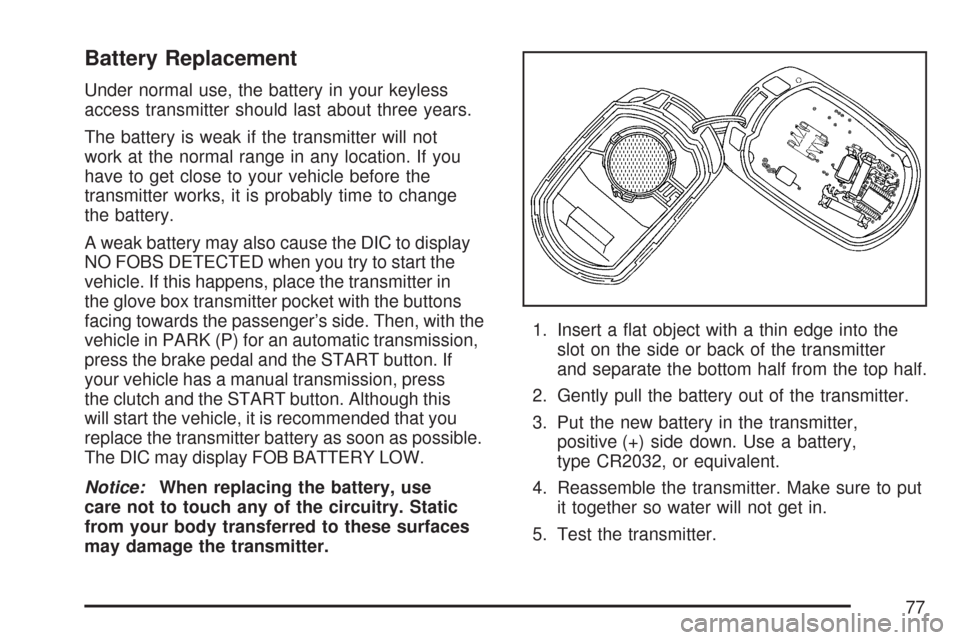
Battery Replacement
Under normal use, the battery in your keyless
access transmitter should last about three years.
The battery is weak if the transmitter will not
work at the normal range in any location. If you
have to get close to your vehicle before the
transmitter works, it is probably time to change
the battery.
A weak battery may also cause the DIC to display
NO FOBS DETECTED when you try to start the
vehicle. If this happens, place the transmitter in
the glove box transmitter pocket with the buttons
facing towards the passenger’s side. Then, with the
vehicle in PARK (P) for an automatic transmission,
press the brake pedal and the START button. If
your vehicle has a manual transmission, press
the clutch and the START button. Although this
will start the vehicle, it is recommended that you
replace the transmitter battery as soon as possible.
The DIC may display FOB BATTERY LOW.
Notice:When replacing the battery, use
care not to touch any of the circuitry. Static
from your body transferred to these surfaces
may damage the transmitter.1. Insert a �at object with a thin edge into the
slot on the side or back of the transmitter
and separate the bottom half from the top half.
2. Gently pull the battery out of the transmitter.
3. Put the new battery in the transmitter,
positive (+) side down. Use a battery,
type CR2032, or equivalent.
4. Reassemble the transmitter. Make sure to put
it together so water will not get in.
5. Test the transmitter.
77
Page 90 of 488
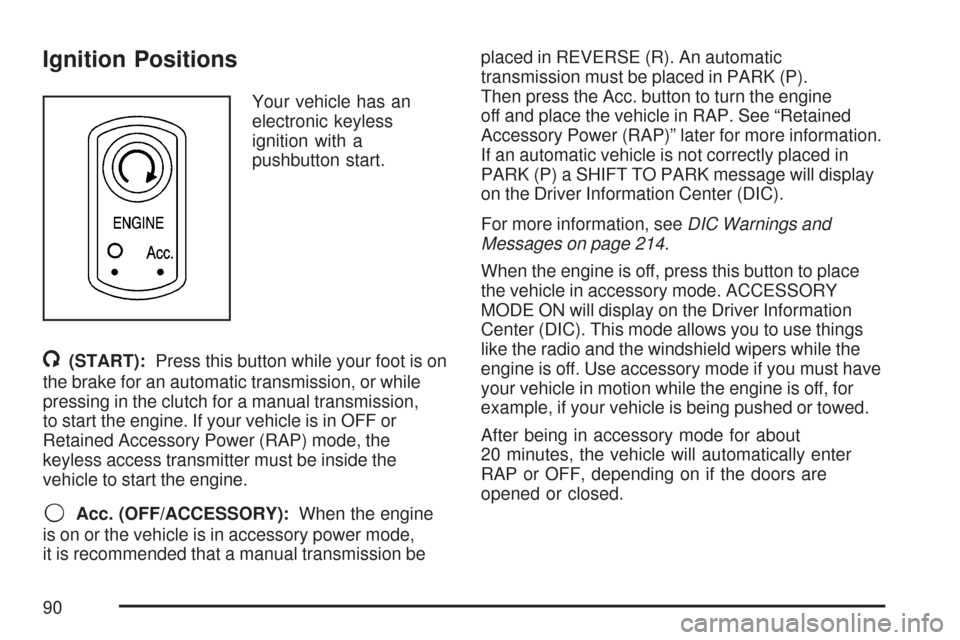
Ignition Positions
Your vehicle has an
electronic keyless
ignition with a
pushbutton start.
/(START):Press this button while your foot is on
the brake for an automatic transmission, or while
pressing in the clutch for a manual transmission,
to start the engine. If your vehicle is in OFF or
Retained Accessory Power (RAP) mode, the
keyless access transmitter must be inside the
vehicle to start the engine.
9Acc. (OFF/ACCESSORY):When the engine
is on or the vehicle is in accessory power mode,
it is recommended that a manual transmission beplaced in REVERSE (R). An automatic
transmission must be placed in PARK (P).
Then press the Acc. button to turn the engine
off and place the vehicle in RAP. See “Retained
Accessory Power (RAP)” later for more information.
If an automatic vehicle is not correctly placed in
PARK (P) a SHIFT TO PARK message will display
on the Driver Information Center (DIC).
For more information, seeDIC Warnings and
Messages on page 214.
When the engine is off, press this button to place
the vehicle in accessory mode. ACCESSORY
MODE ON will display on the Driver Information
Center (DIC). This mode allows you to use things
like the radio and the windshield wipers while the
engine is off. Use accessory mode if you must have
your vehicle in motion while the engine is off, for
example, if your vehicle is being pushed or towed.
After being in accessory mode for about
20 minutes, the vehicle will automatically enter
RAP or OFF, depending on if the doors are
opened or closed.
90
Page 91 of 488
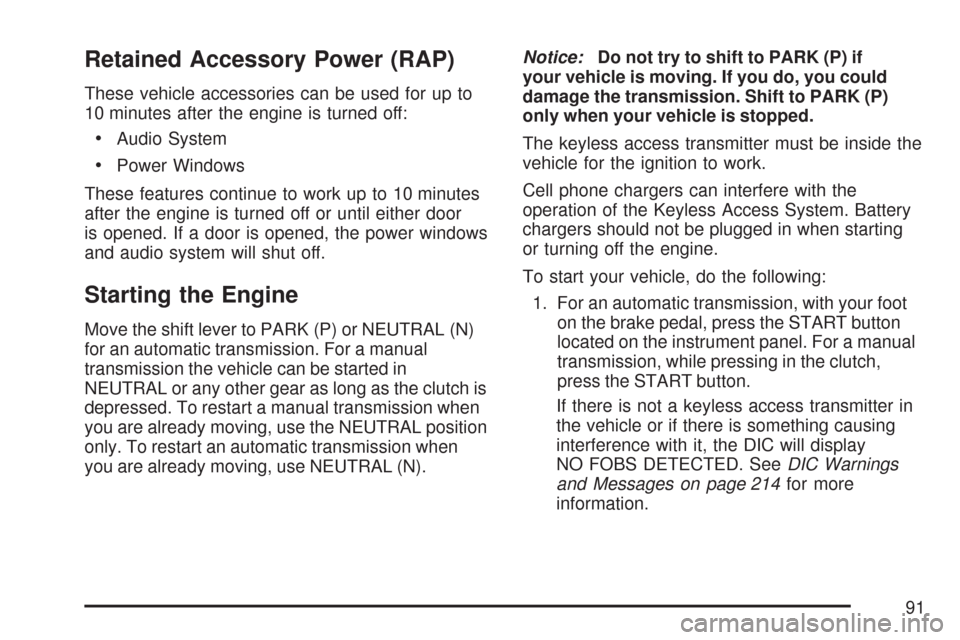
Retained Accessory Power (RAP)
These vehicle accessories can be used for up to
10 minutes after the engine is turned off:
Audio System
Power Windows
These features continue to work up to 10 minutes
after the engine is turned off or until either door
is opened. If a door is opened, the power windows
and audio system will shut off.
Starting the Engine
Move the shift lever to PARK (P) or NEUTRAL (N)
for an automatic transmission. For a manual
transmission the vehicle can be started in
NEUTRAL or any other gear as long as the clutch is
depressed. To restart a manual transmission when
you are already moving, use the NEUTRAL position
only. To restart an automatic transmission when
you are already moving, use NEUTRAL (N).Notice:Do not try to shift to PARK (P) if
your vehicle is moving. If you do, you could
damage the transmission. Shift to PARK (P)
only when your vehicle is stopped.
The keyless access transmitter must be inside the
vehicle for the ignition to work.
Cell phone chargers can interfere with the
operation of the Keyless Access System. Battery
chargers should not be plugged in when starting
or turning off the engine.
To start your vehicle, do the following:
1. For an automatic transmission, with your foot
on the brake pedal, press the START button
located on the instrument panel. For a manual
transmission, while pressing in the clutch,
press the START button.
If there is not a keyless access transmitter in
the vehicle or if there is something causing
interference with it, the DIC will display
NO FOBS DETECTED. SeeDIC Warnings
and Messages on page 214for more
information.
91
Page 100 of 488
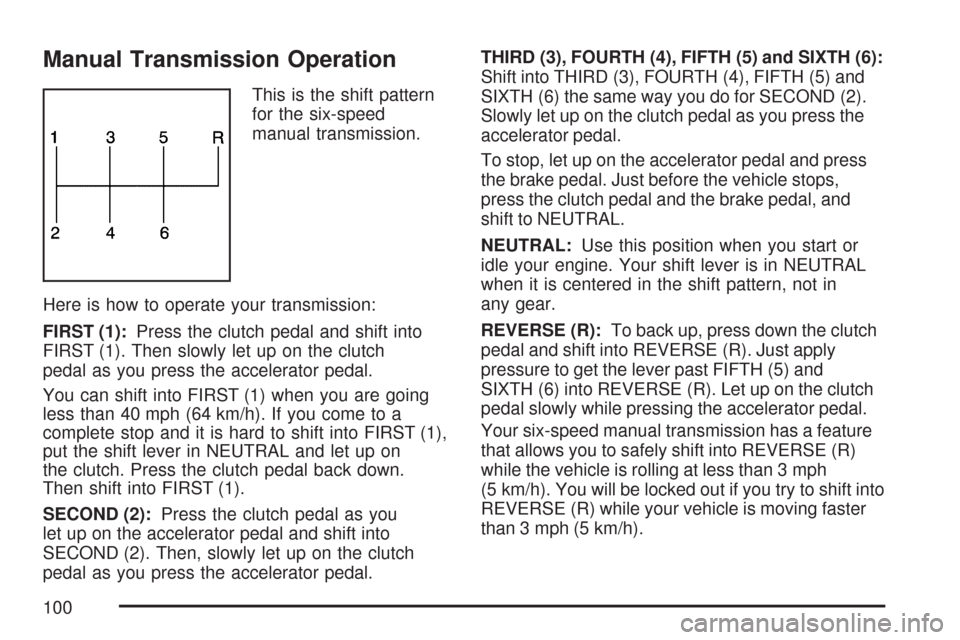
Manual Transmission Operation
This is the shift pattern
for the six-speed
manual transmission.
Here is how to operate your transmission:
FIRST (1):Press the clutch pedal and shift into
FIRST (1). Then slowly let up on the clutch
pedal as you press the accelerator pedal.
You can shift into FIRST (1) when you are going
less than 40 mph (64 km/h). If you come to a
complete stop and it is hard to shift into FIRST (1),
put the shift lever in NEUTRAL and let up on
the clutch. Press the clutch pedal back down.
Then shift into FIRST (1).
SECOND (2):Press the clutch pedal as you
let up on the accelerator pedal and shift into
SECOND (2). Then, slowly let up on the clutch
pedal as you press the accelerator pedal.THIRD (3), FOURTH (4), FIFTH (5) and SIXTH (6):
Shift into THIRD (3), FOURTH (4), FIFTH (5) and
SIXTH (6) the same way you do for SECOND (2).
Slowly let up on the clutch pedal as you press the
accelerator pedal.
To stop, let up on the accelerator pedal and press
the brake pedal. Just before the vehicle stops,
press the clutch pedal and the brake pedal, and
shift to NEUTRAL.
NEUTRAL:Use this position when you start or
idle your engine. Your shift lever is in NEUTRAL
when it is centered in the shift pattern, not in
any gear.
REVERSE (R):To back up, press down the clutch
pedal and shift into REVERSE (R). Just apply
pressure to get the lever past FIFTH (5) and
SIXTH (6) into REVERSE (R). Let up on the clutch
pedal slowly while pressing the accelerator pedal.
Your six-speed manual transmission has a feature
that allows you to safely shift into REVERSE (R)
while the vehicle is rolling at less than 3 mph
(5 km/h). You will be locked out if you try to shift into
REVERSE (R) while your vehicle is moving faster
than 3 mph (5 km/h).
100
Page 102 of 488
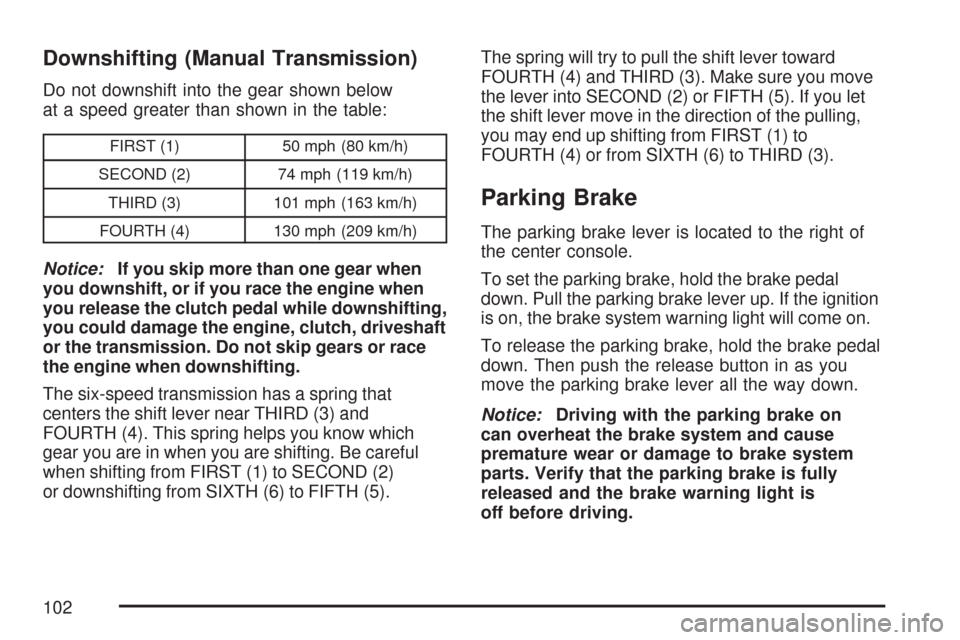
Downshifting (Manual Transmission)
Do not downshift into the gear shown below
at a speed greater than shown in the table:
FIRST (1) 50 mph (80 km/h)
SECOND (2) 74 mph (119 km/h)
THIRD (3) 101 mph (163 km/h)
FOURTH (4) 130 mph (209 km/h)
Notice:If you skip more than one gear when
you downshift, or if you race the engine when
you release the clutch pedal while downshifting,
you could damage the engine, clutch, driveshaft
or the transmission. Do not skip gears or race
the engine when downshifting.
The six-speed transmission has a spring that
centers the shift lever near THIRD (3) and
FOURTH (4). This spring helps you know which
gear you are in when you are shifting. Be careful
when shifting from FIRST (1) to SECOND (2)
or downshifting from SIXTH (6) to FIFTH (5).The spring will try to pull the shift lever toward
FOURTH (4) and THIRD (3). Make sure you move
the lever into SECOND (2) or FIFTH (5). If you let
the shift lever move in the direction of the pulling,
you may end up shifting from FIRST (1) to
FOURTH (4) or from SIXTH (6) to THIRD (3).
Parking Brake
The parking brake lever is located to the right of
the center console.
To set the parking brake, hold the brake pedal
down. Pull the parking brake lever up. If the ignition
is on, the brake system warning light will come on.
To release the parking brake, hold the brake pedal
down. Then push the release button in as you
move the parking brake lever all the way down.
Notice:Driving with the parking brake on
can overheat the brake system and cause
premature wear or damage to brake system
parts. Verify that the parking brake is fully
released and the brake warning light is
off before driving.
102
Page 105 of 488
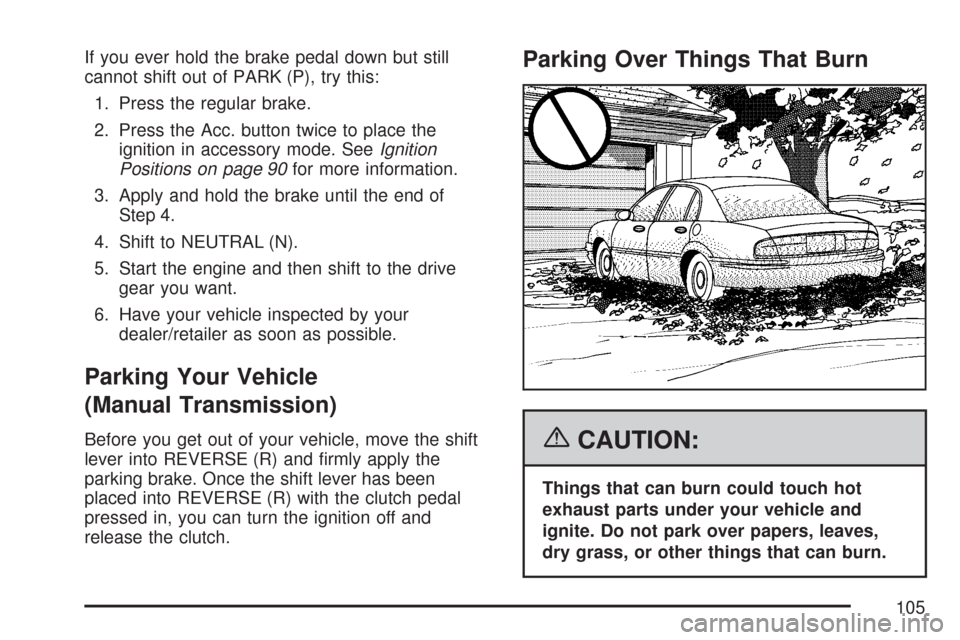
If you ever hold the brake pedal down but still
cannot shift out of PARK (P), try this:
1. Press the regular brake.
2. Press the Acc. button twice to place the
ignition in accessory mode. SeeIgnition
Positions on page 90for more information.
3. Apply and hold the brake until the end of
Step 4.
4. Shift to NEUTRAL (N).
5. Start the engine and then shift to the drive
gear you want.
6. Have your vehicle inspected by your
dealer/retailer as soon as possible.
Parking Your Vehicle
(Manual Transmission)
Before you get out of your vehicle, move the shift
lever into REVERSE (R) and �rmly apply the
parking brake. Once the shift lever has been
placed into REVERSE (R) with the clutch pedal
pressed in, you can turn the ignition off and
release the clutch.
Parking Over Things That Burn
{CAUTION:
Things that can burn could touch hot
exhaust parts under your vehicle and
ignite. Do not park over papers, leaves,
dry grass, or other things that can burn.
105
Page 167 of 488
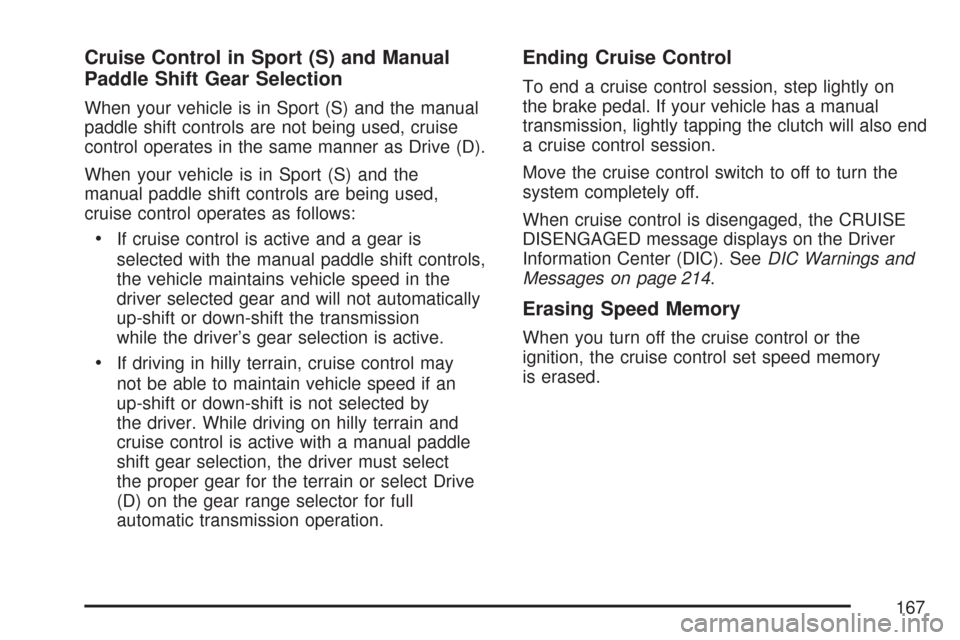
Cruise Control in Sport (S) and Manual
Paddle Shift Gear Selection
When your vehicle is in Sport (S) and the manual
paddle shift controls are not being used, cruise
control operates in the same manner as Drive (D).
When your vehicle is in Sport (S) and the
manual paddle shift controls are being used,
cruise control operates as follows:
If cruise control is active and a gear is
selected with the manual paddle shift controls,
the vehicle maintains vehicle speed in the
driver selected gear and will not automatically
up-shift or down-shift the transmission
while the driver’s gear selection is active.
If driving in hilly terrain, cruise control may
not be able to maintain vehicle speed if an
up-shift or down-shift is not selected by
the driver. While driving on hilly terrain and
cruise control is active with a manual paddle
shift gear selection, the driver must select
the proper gear for the terrain or select Drive
(D) on the gear range selector for full
automatic transmission operation.
Ending Cruise Control
To end a cruise control session, step lightly on
the brake pedal. If your vehicle has a manual
transmission, lightly tapping the clutch will also end
a cruise control session.
Move the cruise control switch to off to turn the
system completely off.
When cruise control is disengaged, the CRUISE
DISENGAGED message displays on the Driver
Information Center (DIC). SeeDIC Warnings and
Messages on page 214.
Erasing Speed Memory
When you turn off the cruise control or the
ignition, the cruise control set speed memory
is erased.
167
Page 218 of 488
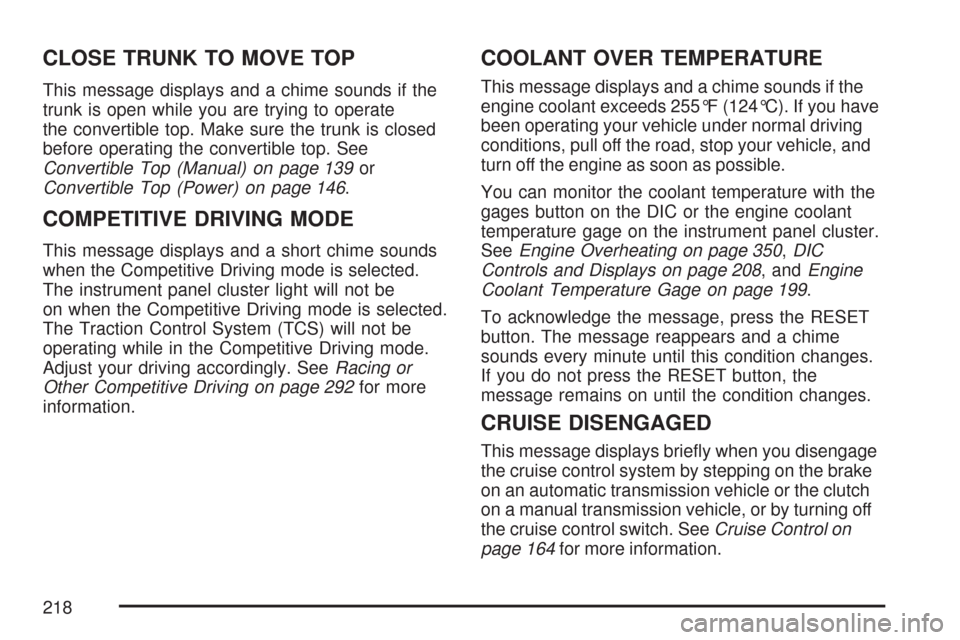
CLOSE TRUNK TO MOVE TOP
This message displays and a chime sounds if the
trunk is open while you are trying to operate
the convertible top. Make sure the trunk is closed
before operating the convertible top. See
Convertible Top (Manual) on page 139or
Convertible Top (Power) on page 146.
COMPETITIVE DRIVING MODE
This message displays and a short chime sounds
when the Competitive Driving mode is selected.
The instrument panel cluster light will not be
on when the Competitive Driving mode is selected.
The Traction Control System (TCS) will not be
operating while in the Competitive Driving mode.
Adjust your driving accordingly. SeeRacing or
Other Competitive Driving on page 292for more
information.
COOLANT OVER TEMPERATURE
This message displays and a chime sounds if the
engine coolant exceeds 255°F (124°C). If you have
been operating your vehicle under normal driving
conditions, pull off the road, stop your vehicle, and
turn off the engine as soon as possible.
You can monitor the coolant temperature with the
gages button on the DIC or the engine coolant
temperature gage on the instrument panel cluster.
SeeEngine Overheating on page 350,DIC
Controls and Displays on page 208, andEngine
Coolant Temperature Gage on page 199.
To acknowledge the message, press the RESET
button. The message reappears and a chime
sounds every minute until this condition changes.
If you do not press the RESET button, the
message remains on until the condition changes.
CRUISE DISENGAGED
This message displays brie�y when you disengage
the cruise control system by stepping on the brake
on an automatic transmission vehicle or the clutch
on a manual transmission vehicle, or by turning off
the cruise control switch. SeeCruise Control on
page 164for more information.
218